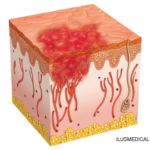Lab Transport & Clinical Implications
In addition to clinical insights, one important point addressed in the study is the lab procedures that can contribute to false negative results. “Strict preanalytical conditions must be respected for cryoglobulin detection, conditions of sampling, transport and treatment, to reduce loss of cryoglobulin responsible for false negative results,” the researchers write.
Despite the use of validated procedures, nearly 9% of patients with a negative first test for cryoglobulins tested positive on a second sample. Thus, in the case of negative detection with a suggestive clinical context, repeat cryoglobulin testing is recommended, say the researchers.
Although it can be challenging to improve sample transportation procedures in a large hospital, it still is important to consistently educate nurses and technicians about cryoglobulin sample detection. The researchers described the best ways to transport blood samples for cryoglobulins in a previous paper (see sidebar, below).2
Takeaways
Rheumatologist Lindsay S. Lally, MD, Hospital for Special Surgery, New York, praises the study’s large patient sample. “It adds much to our understanding about the epidemiology and immunologic phenotypes of cryoglobulinemia,” she says. She was surprised that only 8% of the samples originated from rheumatology, but believes this is part of the heterogenous and multisystem nature of cryoglobulinemic vasculitis.
“Another notable takeaway is the need to repeat testing if your suspicion is high,” Dr. Lally says. “In this cohort, 9% of patients had initial negative testing and then a positive [cryoglobulin test] on repeat testing. This speaks to high false-negative rates.”
Yet another take-home message, according to Dr. Lally: “We often associate rheumatoid factor positive with mixed cryoglobulinemia, but in this population, only 20% of patients with mixed cryoglobulins had a detectable serum rheumatoid factor, and most of these were patients with hepatitis B or C rather than autoimmune disease,” she says.
What’s Next
Researchers plan to next focus on the link between cryoglobulins and hepatitis C infection, says Dr. Miossec, noting physicians look for a hepatitis C infection only in 30% of cases when cryoglobulin is detected. They also will continue ongoing research into the limitations of detecting rheumatoid factor in type II and type III cryoglobulinemic vasculitis.
Vanessa Caceres is a medical writer in Bradenton, Fla.
How to Transport Blood Samples for Cryoglobulins
Nurses and technicians must receive training in the proper way to transport and handle blood samples intended for cryoglobulin testing.1 Proper sampling, transport and care are critical to lower the chances of a false negative test result. Here are a few tips to follow:
- Use preheated tubes during blood collection;
- The sample tube should be carried to the lab in a container that maintains a temperature of 37°C.1,2 This is particularly important for the detection of type I cryoglobulins;
- A preheated centrifuge creates the best conditions for the detection of cryoglobulins at low concentrations; and3
- Allow the serum to cryoprecipitate at 4°C for at least three, and preferably seven, days.3
References
- Kolopp-Sarda MN, Nombel A, Miossec P. Cryoglobulins today: Detection and immunological characteristics of 1,675 positive samples from 13,439 patients obtained over six years. Arthritis Rheum. 2019 Nov;71(11):1904–1912.
- Kolopp-Sarda M-N, Miossec P. Cryoglobulins: An update on detection, mechanisms, and clinical contribution. Autoimmunity Reviews. 2018 May;17(5):457–464.
- Vermeersch P, Gijbels K, Mariën G, et al. A critical appraisal of current practice in the detection, analysis, and reporting of cryoglobulins. Clin Chem. 2008 Jan;54(1):39–43.
